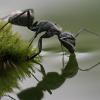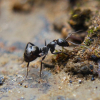Formica fusca is very easy to keep (antkeeping-wise they're basically bigger Lasius niger), they love to walk a lot and are most active during the day which makes them interesting to watch. They are polygynous (you can throw as many queens together as you want) and need lots of tubing (with multiple outworlds although the individual outworlds don't need to be that big) as they love to walk around, but they will not grow larger than about 10000 workers (usually only 5000-6000 workers) no matter how many queens they have which keeps the required nesting space relatively small (unlike Lasius niger which can grow to massive proportions of 50000+ workers). Also they're not as aggressive towards other ants as Lasius niger is (make sure your Lasius niger not only cannot escape but also that they cannot enter the setups of your other colonies should they escape, Lasius niger is very efficient at killing off other ant colonies including capable warrior ants like Pheidole megacephala or Tetramorium species).
Another option is Messor barbarus (not exactly an exotic species as it can be found in Spain, Portugal and even southern France), they're extremely easy to feed (main food source are seeds they store in their chambers, but they will also take the occasional dead insect), can live for months without additional food supply (if they have enough seeds stored) and grow best if disturbed as little as possible (they're the perfect species for a traveling salesman). However these are very creative ants that love to modify their surroundings to fit their needs - they can completely demolish any decorations (so don't bother too much with making their setup look pretty) and even crave out the substrate of an entire outworld to fill the nest or support hill-&tunnel-building operations in another outworld. Their constant building ops makes them very interesting to observe. Note that Messor colonies can grow quite fast though and become quite huge (10000+ workers). They're relatively bad climbers which makes containment rather easy, just don't give them access to any blind-ending vinyl tubing, some colonies start to chew on those when they can grab them at a free-hanging end.
Edited by Serafine, October 21 2017 - 7:54 AM.

















![UA's Lasius latipes [Discontinued] - last post by UtahAnts](https://www.formiculture.com/uploads/profile/photo-thumb-5683.jpg?_r=1633467752)



